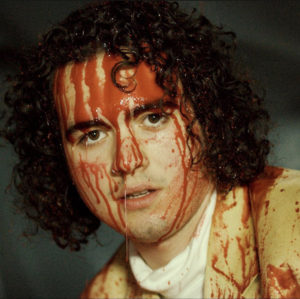How do you define DIY? How do you inspire festivals like Coachella, Lollapalooza, and Burning Man? These are the questions that Stuart Swezey answers successfully with his documentary, Desolation Center, billed as “The untold story of a series of Reagan-era anarchic punk rock desert happenings that still reverberate throughout our culture.”
From 1983 to 1985, Swezey orchestrated a series of events in unconventional locations for LA’s unrested punks under the organized name of “Desolation Center”. The city laws at that time necessitated new spaces for freedom of expression. During the uprise of the hardcore punk genre and public outcry against the weird-looking youth that supported the movement, the Los Angeles police department cracked down on any bill that featured bands with “punk” names, even if they didn’t necessarily make punk music. The general public couldn’t wrap their heads around what punk was and were scared of its violent portrayal in the media. Notable archival footage featured in the doc shows cops in riot gear shutting down a venue that was hosting the Ramones and Black Flag.
Desolation Center opted to push the boundaries of music and art through supporting the musicians and artists who shared the same mindset. The film’s “cast” includes: the Minutemen, Meatpuppets, Sonic Youth, Swans, and performance artists such as Survival Research Laboratories and West Berlin industrial group Einstürzende Neubauten. These shows solidified the Minutemen and Arizona’s Meat Puppets as California staples and, according to Thurston Moore, “Californized” Sonic Youth, effectively introducing them to the West Coast. Before Desolation Center, they’d only played the East Coast and Europe; meeting Swezey for the first time in Berlin.
A handful of these shows took place in the Mojave Desert. For the first, attendees were instructed to get on school buses, unaware of where they would be taken or how to prepare for the harsh desert conditions. Crowdsourced photos and audio recordings show this occurring in the middle of nowhere with the school buses parked in such a way so as to protect the audience and bands from heavy desert winds. The following Desolation Center event saw the Minutemen play on a boat to their hometown audience in San Pedro, followed by the psychedelic music of the Meat Puppets. The “Gila Monster Jamboree” had attendees participate in a crosstown scavenger hunt to find the show. Once they reached the final location, again in the Mojave, they partook in free LSD and a lineup that included Sonic Youth, the Meat Puppets, and Psi/ Com, Perry Farrell’s band before forming Jane’s Addiction.
Desolation Center eventually lost its momentum after Swezey was found out and fined by the government for trespassing laws he thought he had gotten away with. A brief glimpse of hope came after a benefit was thrown to raise funds to cover his debt, followed by a grant gifted from the National Endowment of the Arts. Swezey would use the grant money to throw a Winter Solstice show that featured Swans, Sonic Youth, and Saccharine Trust. The day after, the final nail in Desolation Center’s coffin came with the death of D. Boone, Minutemen’s lead, who was killed in a car accident. Sonic Youth’s Lee Ranaldo recalls using Boone’s amp just the night before.
The greatest benefit to viewers is that the director of the documentary is also the source of the story. If there’s any bias, it’s either irrelevant or unrecognizable. Through his singular vision, Stuart Swezey was able to gather intimate and honest interviews from several attendees who’re much older now, but still punks at heart. One of my favorite stories was from someone who left his parent’s house for several days as a teenager to go to a Desolation Center show. Confused and angry, his parents couldn’t comprehend his decision. The experience was so profound for him that he wrote a letter about it and sent it to his mother who, upon reading it, finally understood and accepted why punk music was so important to him.
What solidifies the documentary’s cultural relevance is the direct evidence of its influence on the creators of Lollapalooza, Coachella, and Burning Man; all multi-million dollar festivals. If Desolation Center never existed, there’s a good chance none of these would either. Swezey acquired interviews with these founders discussing how their attendance of Desolation Center informed their own ideas for starting festivals. A photo is shown of Perry Farrell, who was once Swezey’s roommate, jotting in his notebook at one of the Mojave shows. One of the saddest moments in the documentary is the juxtaposition of footage from Desolation Center cut with footage from the current, commercialized iterations of Burning Man, Coachella, and Lollapalooza; capturing the gravity of “selling out”. Tickets to Desolation Center were never more than $15. A ticket to Burning Man today costs $425 at its lowest price. There was a palpable cringe from the audience at my screening. Desolation Center died in its purest form, before it could ever be corrupted by greed.
Following the documentary, I stayed for a Q&A with Stuart Swezey, Lee Ranaldo and Steve Shelley of Sonic Youth, and Jenn Pelly, a staff writer for Pitchfork who broke the Desolation Center story to the New York Times in this fantastic article. It’s worth noting that she played a role in organizing Silent Barn (RIP).
Here’s a quote I found insightful:
Growing up amid incendiary late-70s L.A. punk, Swezey was galvanized by the self-starting ethos of underground zines and labels. A self-described autodidact who “found out about Nietzsche from Adam Ant,” he followed the great question mark of punk where it led. “What about venues?” he recalled wondering. “How could we question the assumptions of how you see music performed?”
I was one of a few twenty-somethings in my theater. Everyone else was much older and looked like they would’ve been the same age as those who attended Desolation Center shows in the 80’s. I think there’s something to be appreciated about seeing an older generation be nostalgic for something so similar to the life we live and the music scene we support now. Through this documentary, I saw the late-70’s/ early 80’s LA punk movement romanticized and its death lamented. Listening to the director, Lee, and Steve speak, I got to hear first person accounts of pivotal cultural history. To my surprise, there was also someone in the audience who attended one of the Mojave shows and gave Swezey his gratitude. It was a wonderful experience in defining what a music scene is: a collective organization and group of people that really, truly believe in music’s power to absolve and release.
One of my main takeaways was how important it is to take photos, videos, or audio; whatever means necessary to record significant history for an archive we might not know yet. I often get annoyed by photo opportunistic moments and the live acts that vie for the cameras sticking up in the front row at shows; they can come off as cheesy. However, this doc showed me the necessity of recording every moment because similar ones were pivotal in helping Stuart Swezey pull his film together to represent a specific era of music’s cultural timeline. He also made “functional artwork”, designing the Desolation Center tickets. They’re not only sentimental relics, but tangible proof of his events.
On the surface, a director making a documentary about his own story could come off as narcissistic. But when he was asked why he decided to make it, Swezey replied that he eventually realized this was a story that needed to be told. If he didn’t do it, no one else was going to do it. I, for one, am grateful that he did and I think anyone who considers themselves a music lover should be too. If you’ve ever attended Coachella, or Lollapalooza, or Burning Man, or any showcase influenced by those festivals, you have him to credit. There are things we can still learn and grow from this doc and adapt to our own scene; to contemporary music playing, art making, and boundary pushing. Someone in the crowd asked if New York could pull off secret shows in hidden getaways the same way LA had the desert to play with, Swezey commented: “it’s all about being creative, wherever you are.”
You can track screenings of Desolation Center here.















